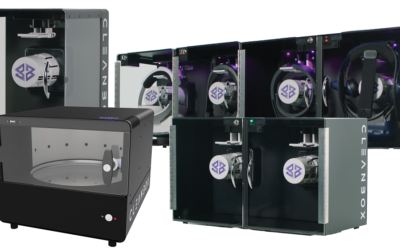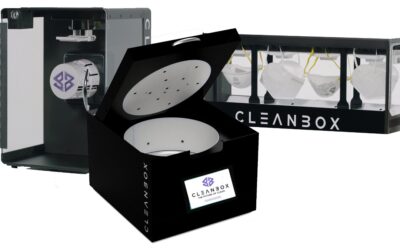Educators are utilizing the Microsoft HoloLens to teach complex concepts and allow students to learn in 3D. The use of mixed reality devices in the higher education space is expected to increase as the devices reduce operating costs, work hours, and lesson time. The implementation of shared technology creates a need for disinfection options. The UV cleaner boxes produced by Cleanbox are ready to meet this need and protect the health of educators and students.
Microsoft’s HoloLens Is Becoming More Common in Classrooms: Here’s How to Keep It Clean
Microsoft’s mixed reality device makes it simple for students to comprehend topics that are challenging to teach from a textbook. When students learn by participating in the curriculum physically, they have a higher retention rate and improved comprehension speed. While it may seem as if shared technology devices in the classroom are a dream come true for students and educators, revolutionary education methods require a new approach to hygiene.
A stumbling block in using shared mixed reality equipment is that the headset can quickly become a vector for pathogens to spread throughout a classroom. Pathogen transmission is typically a more significant issue for lower education, as adults can usually be relied upon to implement proper hygiene practices. But when shared headgear is brought into the mix, educators must ensure rigorous cleanliness standards are met.
Abandon Traditional Solutions
In order to establish why UVC disinfection boxes are the best solution for maintaining the cleanliness of the HoloLens and other shared electronic devices, it’s critical to examine why traditional methods fall short. Before the Covid-19 pandemic, cleaning equipment with disposable wipes might have seemed an acceptable sanitization method. However, the pandemic highlighted how impractical and ineffective many standard disinfection practices are.
Disposable Wipes
There are numerous reasons why disposable wipes have no place as a hygiene staple. Despite the wipes being useful in many situations, they are not a good cleaning option for the Microsoft HoloLens.
Wipes Are Unverifiable
Since the pathogens being eliminated are not visible to the naked eye, students and educators cannot verify whether the device they are using has actually been cleaned. While wipes can knock free any visible debris, such as dirt or hair that could cling to the headset, users can only hope that bacteria and viruses have been removed.
Without using a microscope, which is impractical, there is no way to ensure that the device in question is wholly clean. Therefore, to ensure the health of educators and students is protected, hygiene solutions must be proven and quantifiable.
Wipes Are Inconsistent
When students are in charge of cleaning their equipment at the end of each session, hygiene solutions must work consistently regardless of the user’s experience and the amount of effort they put into cleaning the device. A diligent student may be able to clean a headset fairly adequately using a wipe, but a hurried or distracted student will give the headset a half-hearted swipe that leaves pathogens behind for the following user.
Since there is no way to determine how well the previous user cleaned the device visually, students are forced to place their health in the hands of the last student to use the equipment. For a solution to be entirely practical, it must work as efficiently in the hands of an untrained, unreliable student as in the hands of the most diligent one.
Wipes Are Financially and Physically Wasteful
When devices are used by multiple students throughout multiple classes per week, purchasing enough wipes to maintain sanitary standards becomes a costly venture. Since budgetary limitations are an issue for most educators, finding room for impractical purchases in a budget that shrinks semester by semester is challenging.
From a physical standpoint, wipes contribute to the excess amounts of waste crowding landfills by the year. In addition, disposable wipes, even those marketed as “biodegradable,” are bad for the environment, as the fibers don’t break down entirely. Many brands of alcohol wipes may feel soft to the touch, but they have fine plastic threads woven into the material to improve strength. This resilience during use translates to resilience to decomposition when the wipe is discarded.
Wipes Are Damaging
When disinfecting wipes are thrown out, the chemicals in the wipes leach into the ground, contaminating the soil and water supply. This contamination negatively impacts the ecosystem in the affected area in the short term. Scientists expect to see long-term effects on the biodiversity of plants and animals in the region affected by chemicals.
Additionally, wipes can potentially cause premature degradation to headsets and other electronic equipment. Microsoft cautions users against using bleach-based wipes to clean the HoloLens, stating the concern that the bleach can damage the visor and shell of the device. Wipes with abrasive materials woven into the fabric are also ill-advised, as abrasive components will degrade the equipment and, with continued use, cause it to become non-functional.
Embrace Cleanbox: An Alternative Disinfection Method
UVC cleaning units pair perfectly with mixed reality devices and provide a reliable level of sanitization every single use. For every issue using wipes presents, UVC disinfection systems offer a solution.
UV Cleaner Boxes Are Verifiable
The UVC disinfection units produced by Cleanbox have completed extensive testing and have been proven to perform disinfection at hospital-grade standards. After one sanitizing session, 99.999% of pathogens on the item have been eliminated.
The globally patented LED UVC bulbs used in Cleanbox units are unique, as they target the item being sanitized with the precise intensity level required to eliminate viruses and bacteria, even SARS-Cov2 (Coronavirus). As a result, educators and students can feel relief knowing that their equipment is correctly sanitized by using a cleaning method with a quantifiable level of disinfection.
UV Cleaner Boxes Are Reliable
Any concerns over the reliability of the individual completing the cleaning can be eliminated with UVC disinfection devices. When using this system, all the user has to do is insert the headset into the UVC unit and press the button to begin the cleaning cycle.
In 60 seconds, the user will be cued to remove the headset from the unit. Once the headset has been removed, it is disinfected and ready for use. Any individual can complete the process without instruction or prior experience, as the design is intuitive and impossible to complete incorrectly.
UV Cleaner Boxes Are Ecofriendly and Economic
Each of Cleanboxe’s globally patented UVC LED systems completes approximately 600,000 cleans or 10,000 hours of use. After the initial purchase, the devices will work for years, allowing them to pay for themselves quickly. Unlike other cleaning methods, there are no ongoing expenses such as refills or replacements. Because of the unit’s longevity, using a UVC unit has been proven to be 30X cheaper than purchasing disposable wipes.
Since all UVC units do is emit UVC rays into a controlled space, they don’t harm the environment. While traditional ultraviolet lightbulbs release ozone during use, this can be avoided by only using LED UVC lights for disinfection, as they emit no ozone. As the disinfection unit is entirely self-contained, there is no waste to manage or chemical runoff to pose an environmental concern.
UV Cleaner Boxes Are Gentle on Electronics
It’s challenging to find a way to kill viruses and bacteria without damaging the item being sanitized, especially if the item is an electronic device. UVC units are the most effective way to eliminate pathogens without damaging the item being cleaned or the wearer.
With UVC disinfection, there are no chemicals to potentially irritate the user’s skin or wear down the plastic, and there is no friction to degrade the item’s surface. Even when tested under conditions designed to mimic extreme overuse, LED UVC units did not damage electronic equipment.
If revolutionary learning technology is utilized in the classroom, educators must have hygiene solutions to accompany it. Globally-patented UVC disinfection systems provide a verified clean every use and are an efficient and cost-effective way of maintaining cleanliness standards in the classroom. To learn more about how UVC devices are revolutionizing hygiene practices in the classroom, schedule a virtual demonstration with Cleanbox.





